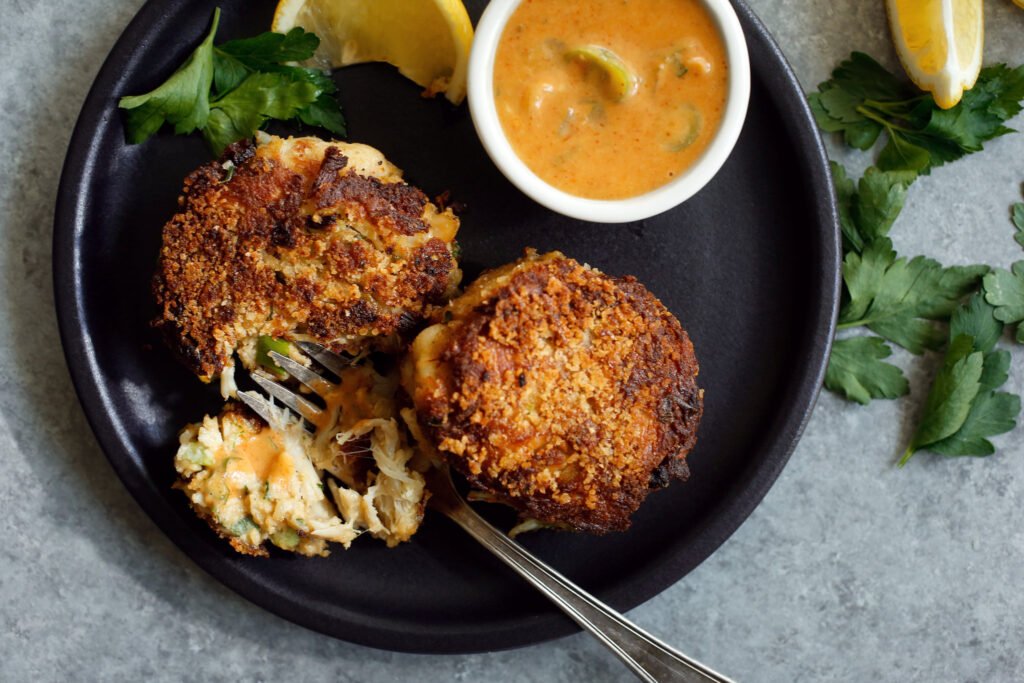
Crab cakes are an exemplary fish delicacy that joins the pleasantness of crab meat with flavorful flavors, it that is firm outwardly and delicate within to frame a scrumptious dish. Whether you’re a fish devotee or another person to the universe of cooking, this itemized guide will walk you through the most straightforward method for making crab cakes. From choosing the right fixings to dominating the cooking system, this article will guarantee you make café quality crab cakes directly in your kitchen.
Understanding Crab Cakes: A Concise Outline
Crab cakes are a staple in beach front food, especially in locales like Maryland, where blue crabs are bountiful. Customarily, crab cakes are produced using crab meat blended in with breadcrumbs, mayonnaise, mustard, eggs, and different flavors. The blend is then framed into patties and either heated, seared, or broiled until brilliant brown. The excellence of crab cakes lies in their adaptability, as they can be filled in as a hors d’oeuvre, principal course, or even in sandwiches.
Sorts of Crab Meat
Prior to plunging into the recipe, it’s fundamental to comprehend the various kinds of crab meat accessible:
Kind sized Irregularity: Huge, white bits of meat from the muscle of the crab. This is the most costly kind of crab meat and is many times utilized in excellent crab cakes for its sweet, fragile flavor.
Irregularity: More modest than enormous knot, yet at the same time comprises of huge lumps of crab meat. It’s somewhat more reasonable and functions admirably in crab cakes.
Backfin: A blend of knot crab meat and more modest bits of meat from the body. It’s a decent harmony among quality and cost, going with it a well known decision for crab cakes.
Paw: More obscure meat from the hooks of the crab. It tastes really more grounded and is more conservative, making it reasonable for the individuals who incline toward a more strong taste.
Exceptional: More modest bits of white crab meat, frequently utilized in soups, plunges, and dishes where the surface of the crab isn’t as essential.
For the best crab cakes, it’s prescribed to utilize enormous bump or protuberance crab meat, as these assortments offer the most flavor and surface. Be that as it may, you can blend in different kinds of crab meat relying upon your financial plan and inclination.
Elements for Simple Crab Cakes
To make the least demanding and most heavenly crab cakes, you’ll require the accompanying fixings:
For the Crab Cakes:
1 pound of crab meat (ideally gigantic irregularity or knot)
1/2 cup of mayonnaise (goes about as a folio)
1 huge egg (likewise a folio)
1 tablespoon Dijon mustard (adds a tart flavor)
1 tablespoon Worcestershire sauce (improves the umami flavor)
1 teaspoon Old Narrows preparing (or any fish preparing of your decision)
1 tablespoon new lemon juice (for a smidgen of citrus)
1/2 cup of breadcrumbs (panko or standard)
2 tablespoons new parsley (slashed, for an explosion of newness)
Salt and pepper to taste
2 tablespoons unsalted spread (for searing)
2 tablespoons vegetable oil (for broiling)
For Serving:
Lemon wedges
Tartar sauce or remoulade sauce
New greens (discretionary, for decorate)
Bit by bit Manual for Making Crab Cakes
Since you have your fixings prepared, we should plunge into the bit by bit course of making crab cakes in the least demanding manner conceivable.
Stage 1: Set up the Crab Meat
Begin via cautiously looking over the crab meat to eliminate any shell parts. While most bundled crab meat is pre-picked, it’s consistently really smart to twofold check to guarantee your crab cakes are without shell. Tenderly separation the crab meat into more modest pieces if essential, yet be mindful so as not to shred it to an extreme – you need to hold a few bigger lumps for surface.
Stage 2: Blend the Wet Fixings
In an enormous blending bowl, join the mayonnaise, egg, Dijon mustard, Worcestershire sauce, Old Cove preparing, and lemon juice. Whisk the fixings together until they are very much joined. This combination will go about as the fastener that holds the crab cakes together.
Stage 3: Add the Crab Meat and Flavors
Delicately overlap the crab meat into the wet combination, being mindful so as not to overmix. The objective is to cover the crab meat equally with the combination while protecting the surface of the crab. Add the hacked parsley, salt, and pepper, and crease again until the fixings are equally dispersed.
Stage 4: Consolidate the Breadcrumbs
Add the breadcrumbs to the crab combination, collapsing them in delicately. The breadcrumbs will assist with restricting the crab cakes and give them structure. Begin with 1/2 cup of breadcrumbs, and in the event that the blend feels excessively wet, add somewhat more until it arrives at the ideal consistency. The blend ought to be soggy however firm to the point of holding its shape when framed into patties.
Stage 5: Structure the Crab Cakes
Utilizing your hands, structure the crab combination into patties. You can make them as enormous or little as you like, yet a typical size is around 3 creeps in measurement and 1 inch thick. Put the framed crab cakes on a baking sheet fixed with material paper. Assuming the combination is excessively tacky, you can softly clean your hands with flour to assist with forming the patties.
Stage 6: Chill the Crab Cakes
When the crab cakes are framed, chilling them in the cooler for something like 30 minutes is significant. This step helps the crab cakes firm up, making them simpler to deal with during cooking and lessening the gamble of them going to pieces.
Stage 7: Cook the Crab Cakes
After the crab cakes have cooled, now is the right time to cook them. There are a few techniques you can utilize, however sautéing is one of the simplest and best ways of accomplishing a fresh outside and a delicate inside.
Sautéing:
In a huge skillet, heat the margarine and vegetable oil over medium intensity. The mix of margarine and oil keeps the spread from consuming while as yet giving a rich flavor.
When the margarine is liquefied and the oil is shining, cautiously place the crab cakes in the skillet. Cook them in clumps if essential, it isn’t stuffed to guarantee the skillet.
Broil the crab cakes for around 3-4 minutes on each side, or until they are brilliant brown and firm. Utilize a spatula to painstakingly flip the crab cakes, taking consideration not to break them.
Once cooked, move the crab cakes to a plate fixed with paper towels to deplete any overabundance oil.
Elective Cooking Techniques:
Baking: Preheat your broiler to 375°F (190°C). Put the crab cakes on a baking sheet fixed with material paper and heat for 12-15 minutes, or until they are brilliant brown and cooked through. For additional freshness, you can cook them for the last 2-3 minutes of baking.
Searing: Preheat the oven on high. Put the crab cakes on an oven dish or a baking sheet fixed with aluminum foil. Sear the crab cakes for 4-5 minutes on each side, or until they are brilliant brown and cooked through. Watch out for them to forestall consuming.
Stage 8: Serve the Crab Cakes
Crab cakes are best served hot, directly from the skillet or broiler. Plate them with lemon wedges and your decision of tartar sauce or remoulade sauce. The new greens can be utilized as a topping or as a bed for the crab cakes. The citrusy punch from the lemon juice supplements the rich kind of the crab, while the sauce adds a smooth, tart differentiation.
Stage 9: Putting away and Warming Extras
Assuming you have any extra crab cakes, store them in an impermeable holder in the cooler for as long as 3 days. To warm, place them in a preheated 350°F (175°C) stove for 10-15 minutes, or until they are warmed through. You can likewise warm them in a skillet over medium intensity for a couple of moments on each side. Try not to microwave crab cakes, as this can make them soaked.
Stage 10: Tips and Deceives for Amazing Crab Cakes
Utilize New Crab Meat: New crab meat will give your crab cakes the best flavor. On the off chance that new crab isn’t accessible, top notch canned or purified crab meat is a decent other option.
Don’t Overmix: While joining the crab meat with different fixings, be delicate. Overmixing can separate the crab meat and result in a soft surface.
Cool the Crab Cakes: Cooling the crab cakes prior to cooking is pivotal. It assists them with holding their shape and keeps them from going to pieces during cooking.
Cook at the Right Temperature: If sautéing, ensure your skillet is hot enough prior to adding the crab cakes. This guarantees a firm outside and forestalls the crab cakes from absorbing a lot of oil.
Present with a New Plate of mixed greens: For a quick bite, serve crab cakes with a new plate of mixed greens of leafy greens, avocado, and a citrus vinaigrette. The acridity from the dressing matches flawlessly with the extravagance of the crab cakes.
Stage 11: Varieties of Crab Cakes
While the exemplary crab cake recipe is a #1, there are a few varieties you can attempt to suit various preferences:
Zesty Crab Cakes: Add finely cleaved jalapeños or a smidgen of hot sauce to the crab blend for a hot kick.
Spice Implanted Crab Cakes: Blend in new spices like dill, tarragon, or chives for a fragrant bend.
Asian-Motivated Crab Cakes: Integrate fixings like ginger, soy sauce, and green onions into the crab combination, and present with a plunging sauce of soy sauce and rice vinegar.
Without gluten Crab Cakes: Substitute the breadcrumbs with without gluten breadcrumbs or squashed sans gluten wafers for a sans gluten variant.
Low-Carb Crab Cakes: For a low-carb choice, supplant the breadcrumbs with almond flour or squashed pork skins.
Stage 12: Matching Crab Cakes with Sides and Beverages
Crab cakes can be matched with different sides and beverages to make a total dinner:
Sides: Serve crab cakes with simmered vegetables, coleslaw, or a corn and tomato salad. Pureed potatoes or a velvety polenta likewise make phenomenal backups.
Drinks: A fresh white wine, for example, Chardonnay or Sauvignon Blanc, coordinates perfectly with crab cakes. For a non-alcoholic choice, attempt a shining water with a sprinkle of lemon or a virus glass of chilled tea.
End
Making crab cakes at home is more straightforward than you could naturally suspect, and with this nitty gritty aide, you’re well en route to dominating this delectable dish. By following the means framed above, you’ll make crab cakes that are fresh outwardly, delicate within, and overflowing with flavor. Whether you’re serving them as a starter or a fundamental course, these crab cakes make certain to intrigue your loved ones. Partake in your culinary creation, and don’t be shocked on the off chance that these crab cakes become another number one in your recipe collection!






Comments by uzairchippa066@gmail.com